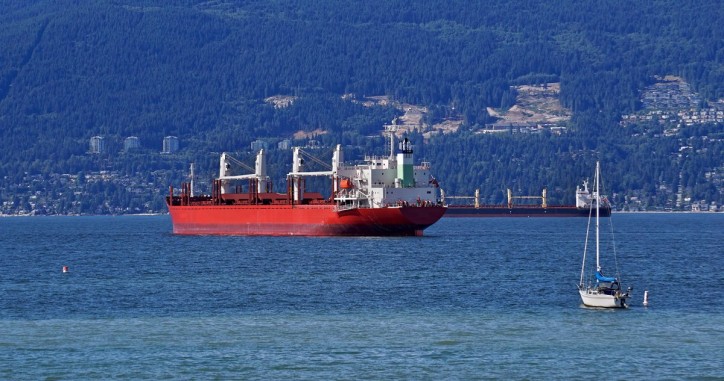Cargo ships, Burrard Inlet, near Vancouver, British Columbia Port authority and the Vancouver Police Department Marine Unit encourage boaters to follow safe boating practices after surge of near-miss incidents
With a rise in near-miss incidents in the Burrard Inlet this year, the Vancouver Fraser Port Authority and the Vancouver Police Department Marine Unit are strongly encouraging boaters to follow the safe boating guidelines to be better prepared, informed, and safe on the water this summer.

“Knowing the ‘rules of the road’ for Canada’s waterways helps everyone avoid collisions by setting out what every boater should do to avoid hitting or being hit by another vessel,” said Stephen Brown, interim harbour master of the Vancouver Fraser Port Authority. “The first and second narrows are busy commercial transit channels, so it is critically important for anyone out on the water in these areas to stay out of the shipping lanes in order to be safe.”
As more recreational boaters and paddlers head out on the water during the summer months, the port authority is seeing an uptick in near-miss incidents in the first and second narrows (waters under and around the Lions Gate and Iron Workers Memorial bridges) where deep-sea commercial ships transit daily. Reviewing the safe boating guidelines and understanding how to navigate the channel is key for the safety of pleasure craft operators and commercial vessels alike, but is often overlooked.
“One of the most important things boaters can do to increase safety for all vessels is to remain aware – aware of the conditions, of other boats, and of the rules on the water,” says VPD Sergeant Jason Robillard. “If you’re a boater, you are responsible for ensuring you know how to stay safe on the water. Most operators know that drinking and boating don’t mix, and everyone on board should always be wearing a personal flotation device. Be alert and always practice safe and responsible boating.”
Recently, the port authority implemented a temporary and voluntary 15-knot speed restriction in the First Narrows Traffic Control Zone to encourage recreational boaters to slow down when transiting the area. Commercial ships are already required to travel at 10 knots. During the summer months when the weather warms up, this channel typically becomes very congested with recreational boats, as well as human-powered pleasure crafts including kayaks, canoes and paddle boards. Fast-moving boats pose a danger to the smaller watercraft.
“At this time of the year, we see a lot of people on the water who are seasonal boaters and not as familiar with the waterways, which can put them at risk. Reviewing the safe boating guidelines before getting out on the water is the best way to prepare yourself and stay safe,” continued Brown. “If there are two key points we encourage recreational boaters to remember, they are to stay to the right of the channel – the same way you do when driving on a road – and to always be aware of other vessels around you.”
The port authority encourages everyone planning to be on the water during the August long-weekend to review the safe boating guidelines and follow the rules of the water.
Here are 10 reminders to stay safe on the water:
- Stay to the right of the channel – The same way you drive on a road, it is important to stay to the right of the channel and out of the middle of the deep-sea vessel traffic channel. Steering clear of the deep-sea vessel route is key to maintaining safety for all on the water.
- Be aware of emergency response vessels – Stay 50 meters or more away from emergency response vessels attending an incident. These vessels can be identified by their active blue strobe lights.
- Yield to commercial vessels – Large, deep-sea ships have limited visibility – don’t assume they can see you. They also can’t move quickly, especially in narrow channels. Be prepared to move. You must yield to them.
- Boating at night is different – It’s more difficult to see your surroundings at night, so be sure to have the proper lighting and safety equipment on board if boating at night. Take extra precaution and go slower.
- Pay attention to your surroundings – Always be aware of other vessels around you and comply with the restricted areas. If you hear five or more short and rapid blasts of a ship’s whistle, it means you’re in immediate danger and must clear the area. Monitor VHF (Very High Frequency) 16 and 12 on your radio.
- Go slowly – The waters are busier this time of year. Go a little slower, give yourself more time and plan your day accordingly.
- Consult official publications – To avoid collision and groundings, look at nautical charts for depth soundings and our website for bridge and transit procedures.
- Never get between a tugboat and its tow – Tow cables are often submerged and not visible.
- Boat respectfully – Keep wake and wash to a minimum to avoid damage to sensitive habitat, property or other vessels. Remember, no wake is permitted when passing moored seaplanes. Large wakes can do damage to or endanger small craft and docks.
- Report incidents – If you see anyone violating the safe boating practices, contact the Port Authority Operations Center 24/7 at: 604.665.9086 to report the incident. In an emergency, press *16 on your mobile phone, VHF: 16 on your radio or, as always, you can phone 911.
The Vancouver Fraser Port Authority is responsible for maintaining the safe and efficient movement of marine traffic within the Port of Vancouver. In partnership with other agencies, the port authority regularly assists to keep shipping lanes clear of small vessel traffic.
Source: Port of Vancouver